Under Thomas Frank, Tottenham have developed into one of the Premier League’s most tactically flexible and well-drilled sides. Frank’s Tottenham are a team that can dominate possession with structure and control but are equally dangerous when pressing high or counterattacking with intensity. His approach blends positional discipline with fluid attacking movements, allowing the team to adapt seamlessly between different phases of play. This tactical analysis explores how Tottenham build up from the back, create chances through wide areas, attack with numbers, and defend using a high-intensity man-oriented system.
Offensive Phase
Thomas Frank’s Tottenham displays a structured yet fluid attacking approach, built around manipulation of the opposition’s press and intelligent occupation of space. His offensive organization combines the positional clarity needed for control with the vertical, dynamic instincts that characterized his Brentford teams.
Low Build-Up
In the first phase of possession, Tottenham typically sets up in a 4-2-3-1 structure, but this often morphs into a 4-2-2-2 shape as the striker drops deeper alongside the number ten. This movement creates a midfield box with no fixed striker, while both wingers stay high and wide to stretch the opposition’s defensive line and pin their fullbacks.
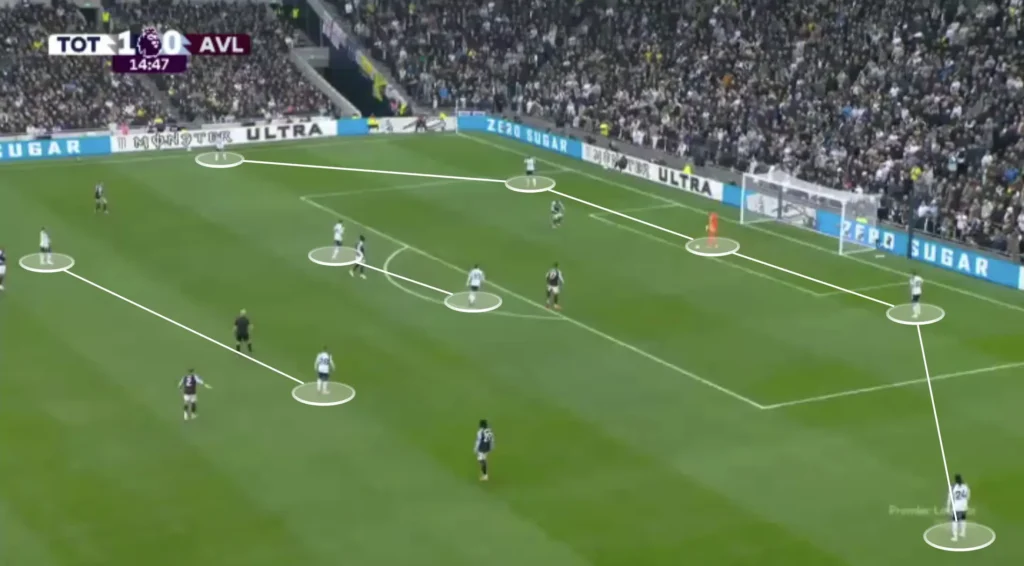
The double pivot provides stability in front of the center-backs, helping Tottenham control the early build-up and play out calmly under pressure. By dropping many players close to the ball, Frank’s side naturally attracts several opposition players forward. In today’s game — where most teams defend with man-oriented pressing systems — this movement pulls defenders out of position and opens up large spaces in behind for Tottenham’s wingers to attack.
Once the press is engaged, Tottenham look to find a forward-facing midfielder or fullback who can quickly exploit these spaces with a vertical pass. This often leads to fast, direct attacking transitions from structured build-up situations, creating 3v3 or 4v4 attacks in open space — almost like a controlled counterattack launched from organized possession.
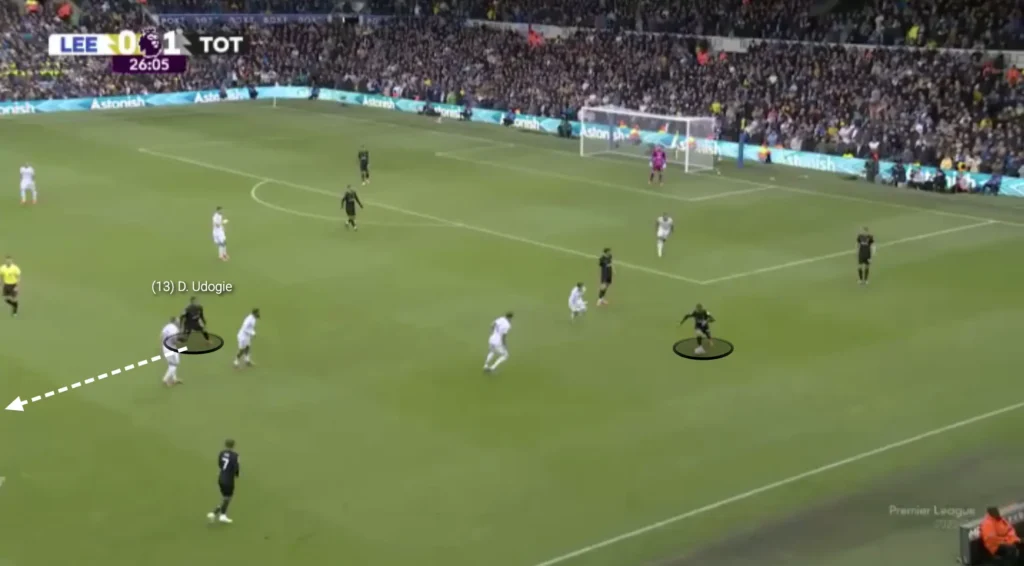
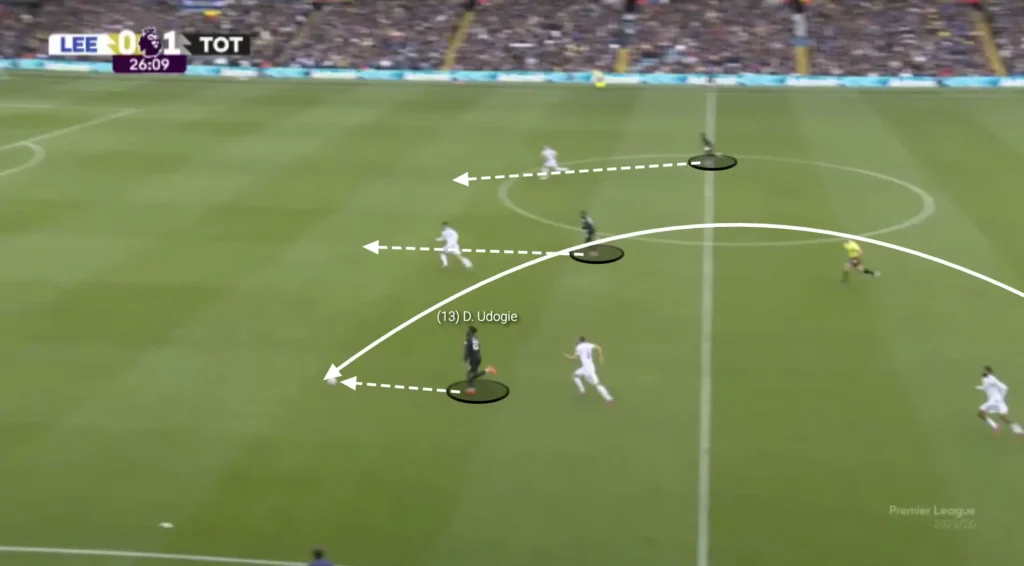
High Build-Up
As Tottenham progress into the middle third, the shape typically evolves into a fluid 4-3-3.
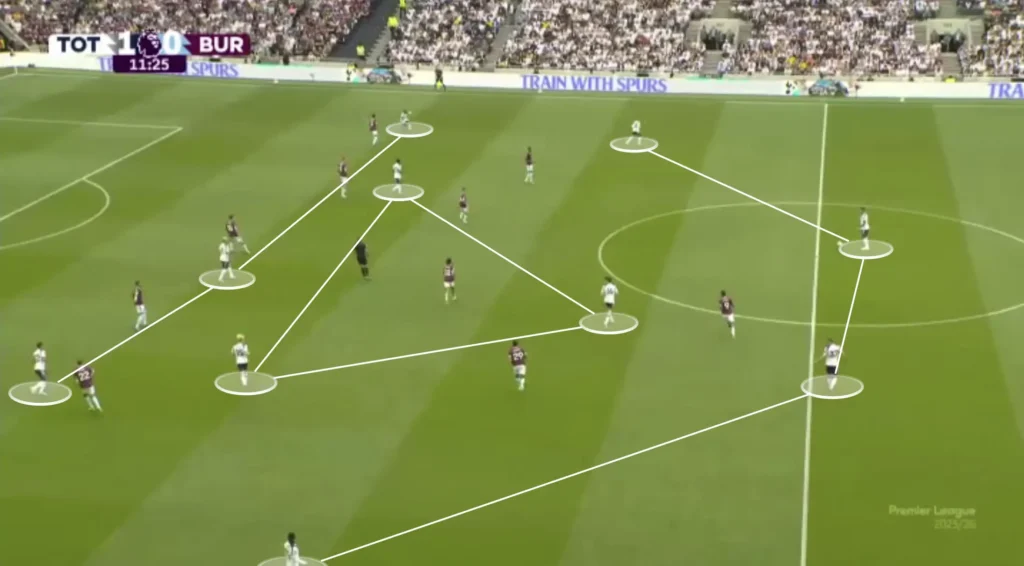
The midfield trio’s movements are key: one of the number eights often drops alongside the holding midfielder to support circulation, while the other pushes higher between the lines. Against teams pressing with two forwards, the number six frequently drops between the center-backs, giving Tottenham a temporary back three to facilitate ball progression and bypass the first line of pressure.
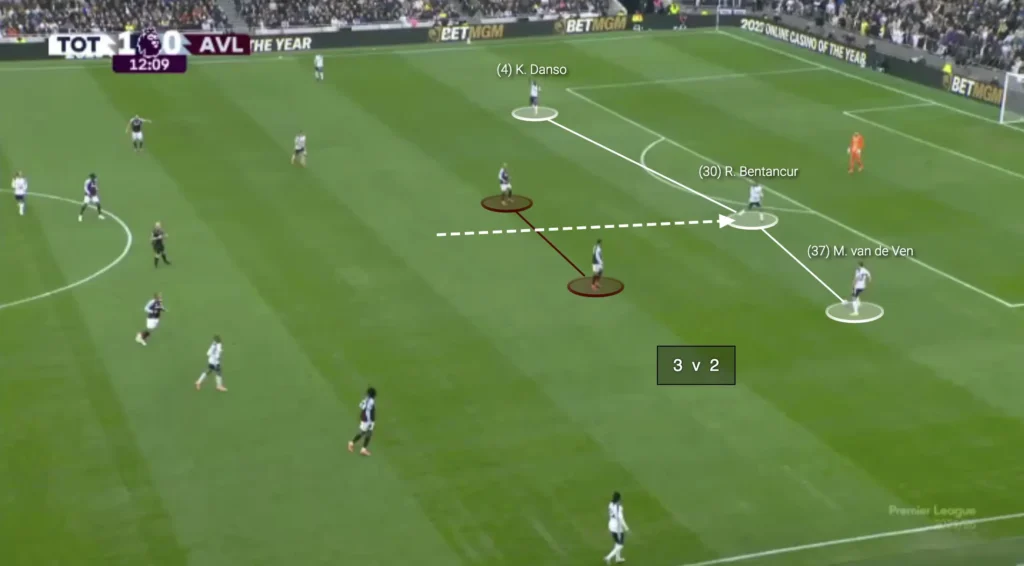
This fluidity makes the structure flexible and unpredictable. Tottenham can build through the center, or shift play wide when under central pressure. Their ability to vary the tempo — moving from short combinations to sudden vertical passes — gives them both possession control and penetration.
Double Width
A key feature of Frank’s offensive structure is the consistent use of double width. Both the fullbacks and wingers occupy wide corridors simultaneously, even when the ball is on the opposite side. This spacing stretches the opponent’s defensive block horizontally and creates several tactical advantages.
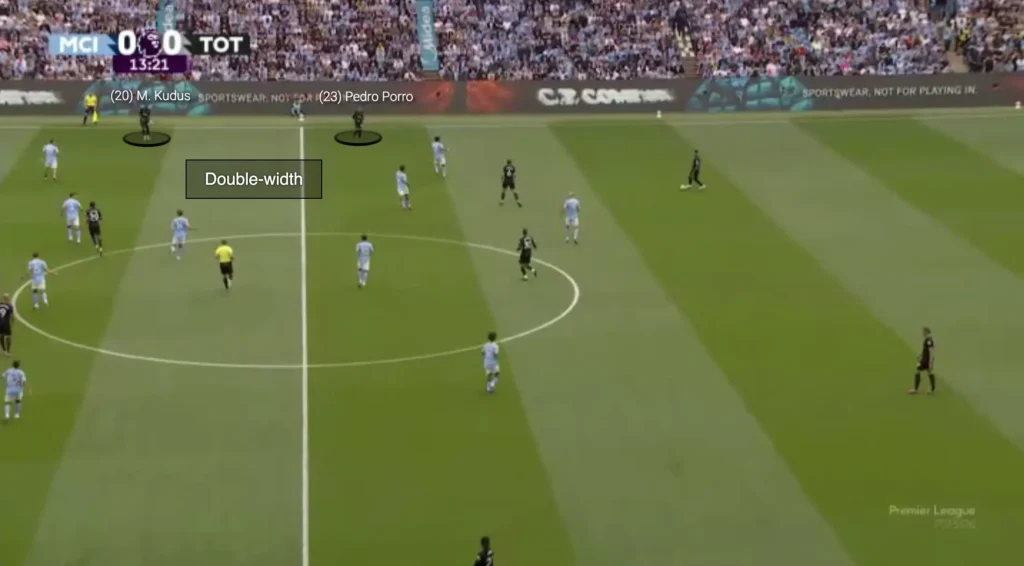
Firstly, maintaining two players wide allows Tottenham to create overloads after switching play. When the ball is circulated from one side to the other, the fullback and winger can immediately form 2v1 or 3v2 situations against the opposition fullback, especially if the near-side midfielder joins the combination.
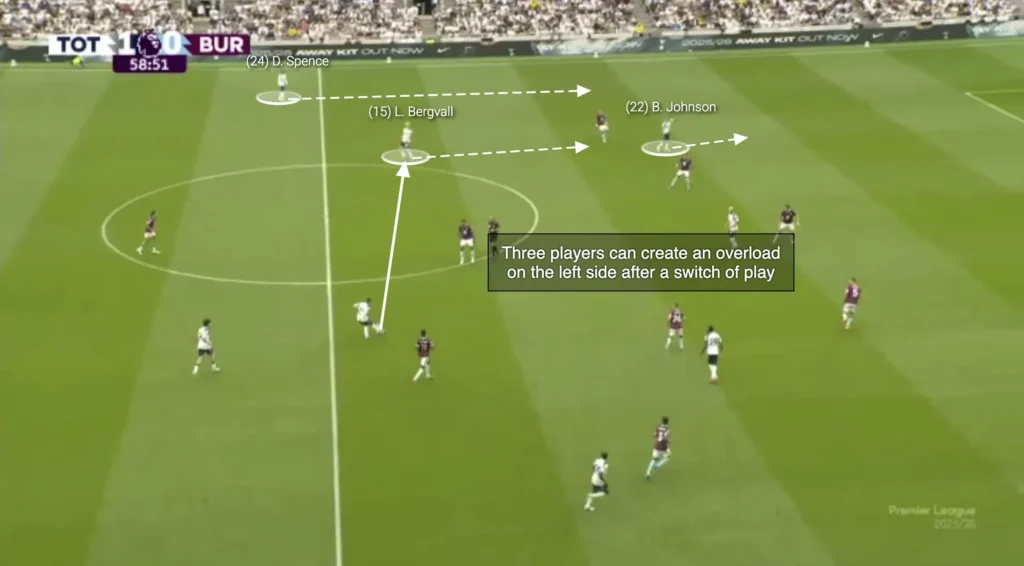
These overloads work particularly well because Spurs’ wide players deliberately hold their width until the switch, fully stretching the opponent’s defensive shape.
Secondly, the double width opens up central lanes. As opponents stretch to cover both wide players, the midfield zone becomes less congested. This benefits Tottenham’s deeper midfielders, who find more time to receive and turn in possession. It’s especially valuable against modern man-oriented pressing systems, where forcing defenders to cover wide zones breaks their marking chains and generates space between the lines.
Finally, maintaining such wide spacing naturally comes with defensive trade-offs. When two players remain on the far side and the team stretches horizontally, Tottenham’s rest-defence becomes more exposed, as there are fewer players positioned close to the ball in case of a turnover. This can leave open spaces for the opposition to counter through.
However, Frank’s side has managed these risks intelligently. The midfielders react instantly after losing possession, working tirelessly to close down transitions, while defenders like Micky van de Ven and Cristian Romero dominate 1v1 duels, helping the team recover quickly and stay stable even when their structure stretches.
Chance Creation Through the Wings
Tottenham’s primary route to chance creation under Frank often comes from attacking through wide areas. The team uses coordinated movements and rehearsed patterns to progress down the flanks and access the box from advantageous positions.
These patterns are based on rotations between the winger, fullback, and nearby midfielder, designed to unbalance defenders and manipulate the opponent’s last line. The aim is not just to cross, but to create high-quality situations where runners can attack the box or find cut-back opportunities from the half-space.
Overlaps
Their most common wide combination is the overlap, where the fullback advances around the outside of the winger. As the winger carries the ball inward, he drags the opposition fullback with him, freeing space for the overlapping run. The fullback then receives in stride, often near the byline, to deliver low crosses or cut-backs.
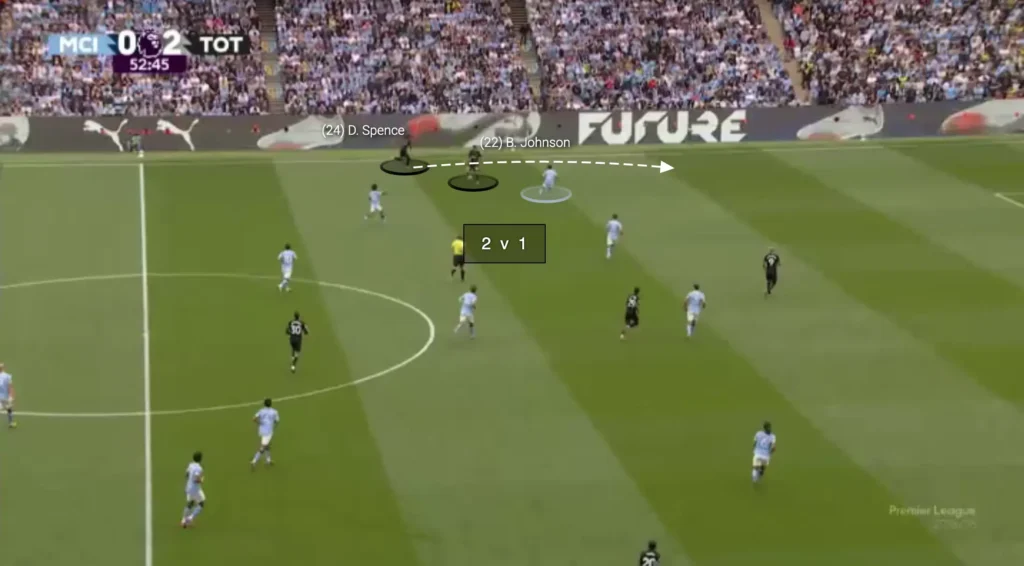
Underlaps
Tottenham also frequently uses underlapping runs, particularly on the right side. Here, the fullback or inside midfielder runs between the opposition fullback and center-back, offering an interior passing option closer to goal.
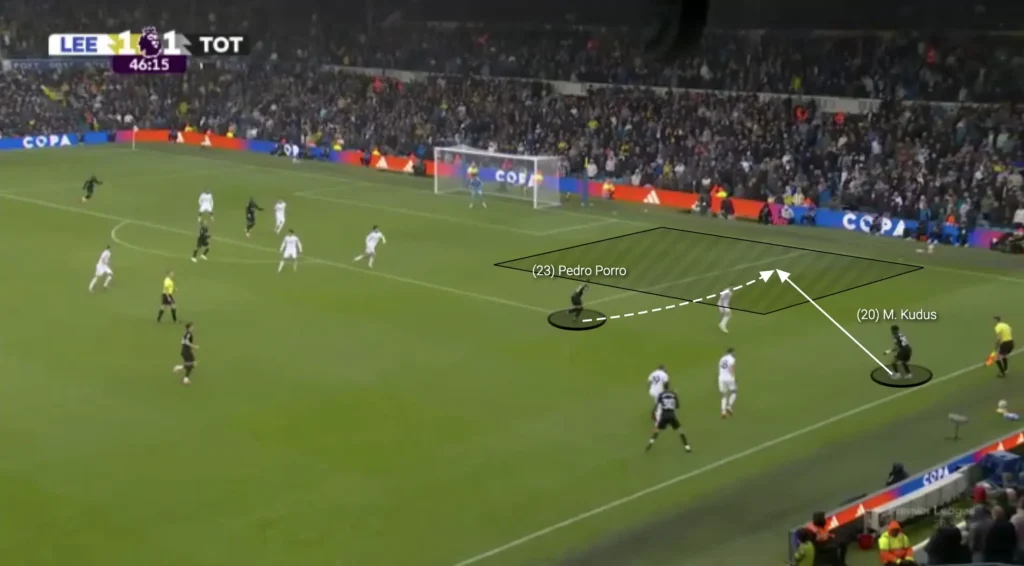
Underlaps are particularly effective when the winger stays very wide. This forces the opposition fullback to defend the outside channel, leaving a gap in the inner corridor. Once the underlap is played, Tottenham can either drive directly into the box or play short combinations to open up cut-back or crossing angles.
These movements also tend to open up new possibilities for the winger. When a teammate makes an underlapping run, the defending midfielder and center-back are often drawn to track it, which momentarily frees the space inside for the winger.
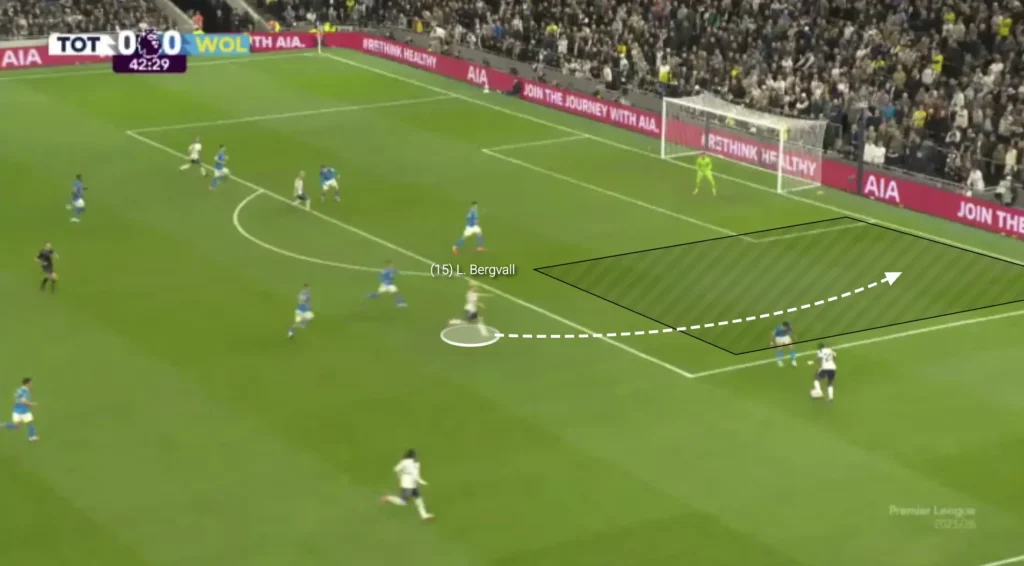
This allows the winger to cut inside with the ball, attack the half-space, or deliver a cross or shot with more time and less pressure.
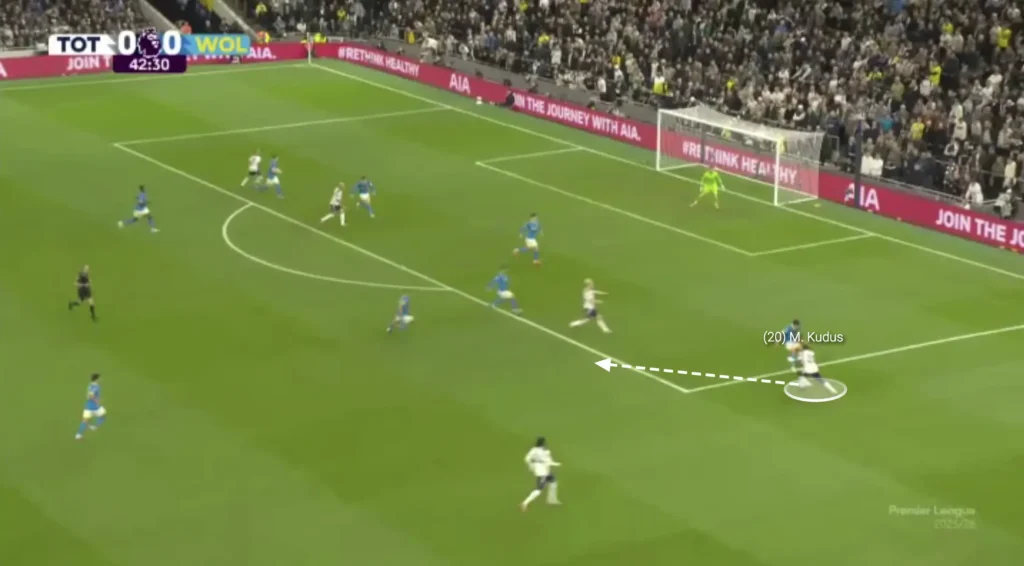
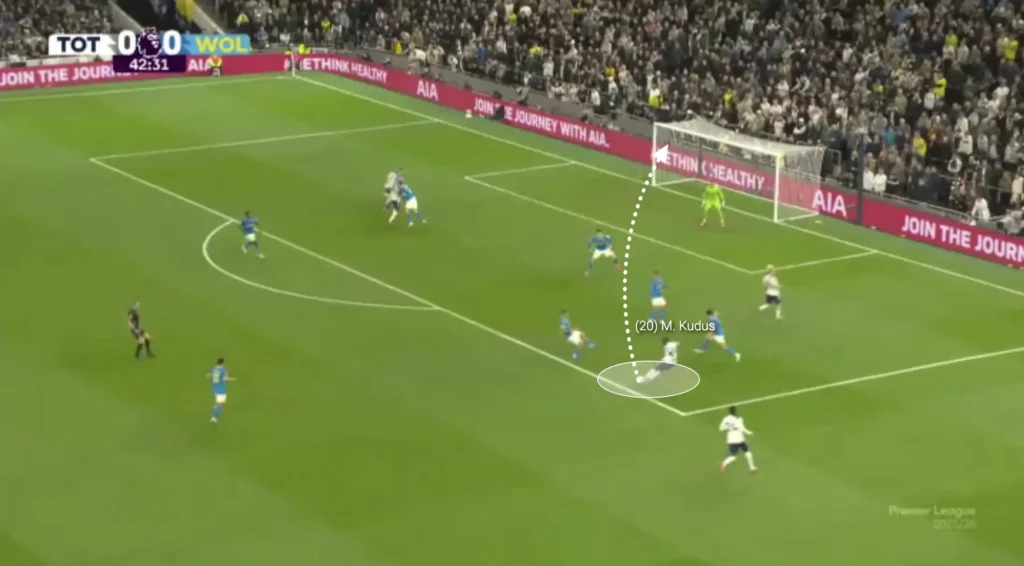
Third-Man Runs
Another recurring pattern in Frank’s system is the use of third-man runs to progress and penetrate through the wings. These typically begin with the winger receiving to feet and drawing pressure, before finding an inside midfielder or forward positioned higher up the pitch. That second player then releases the advancing fullback — the third man — who runs in behind the defensive line.
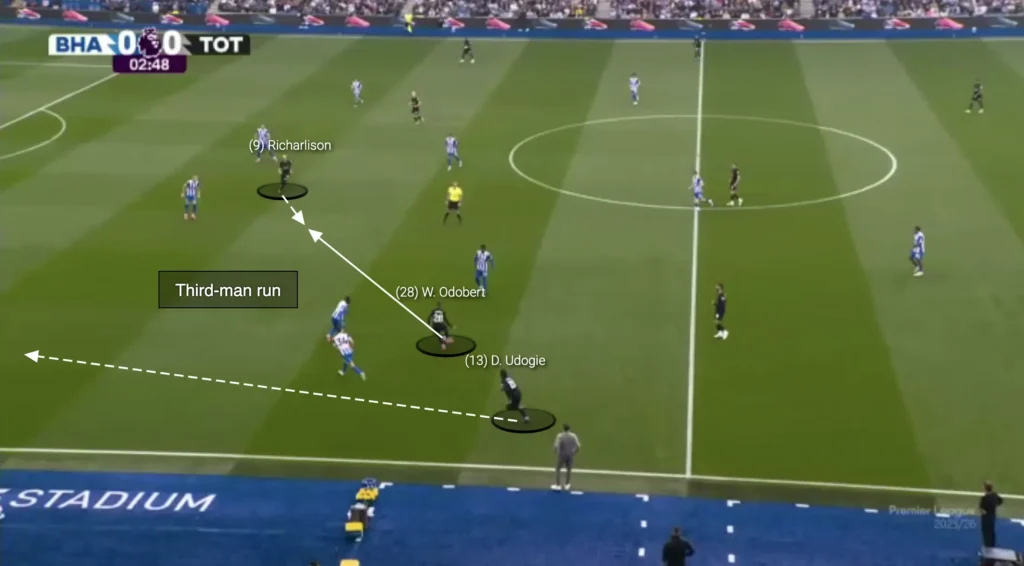
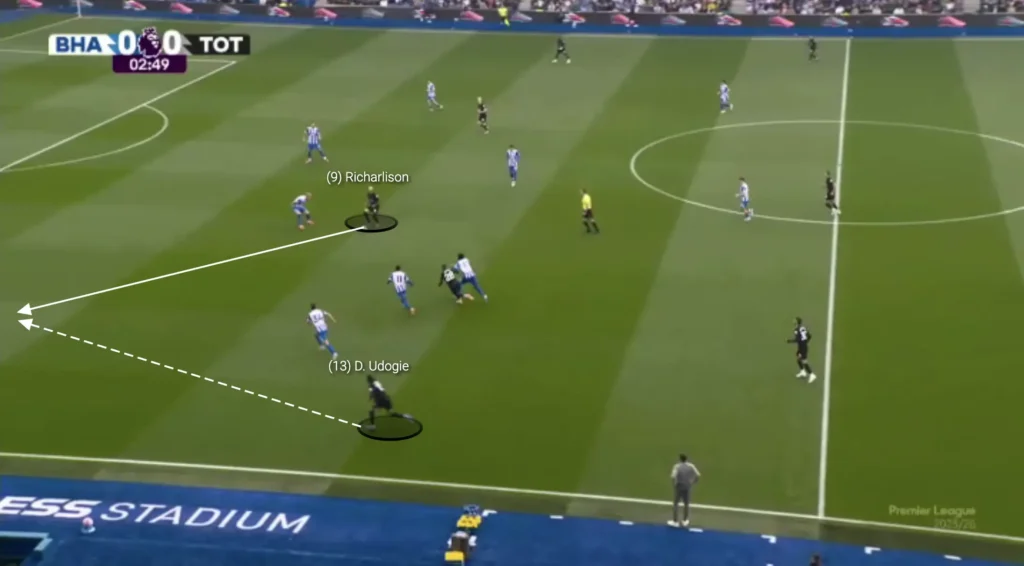
Getting Players into the Box
Thomas Frank also places a strong emphasis on getting multiple players into the box, aiming to create a chaotic environment for defenders and increase the likelihood of converting crosses into goals. When the ball reaches the final third, Tottenham’s attackers and midfielders make aggressive, well-timed runs into the penalty area, often committing four or five players forward.
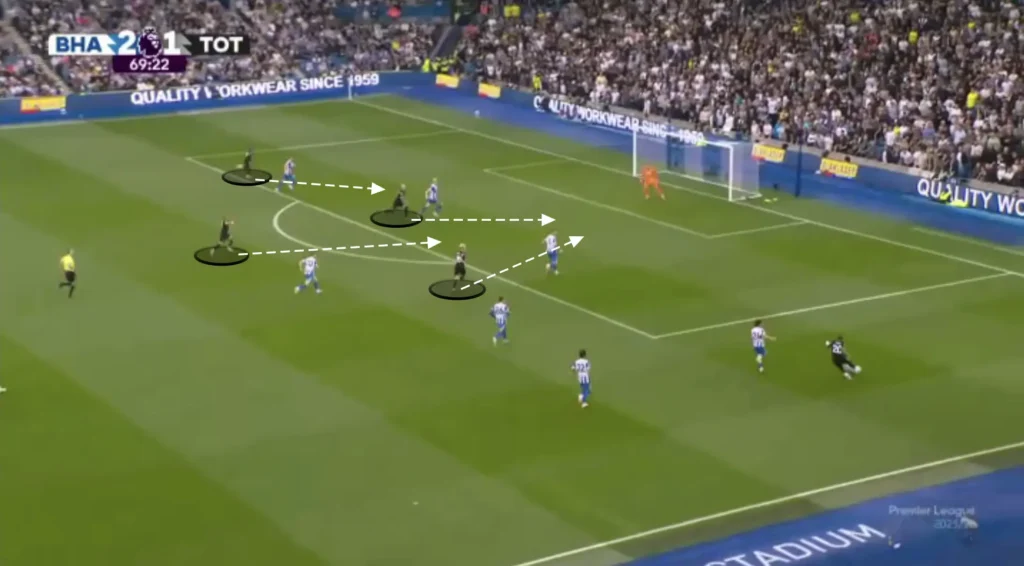
This consistent commitment to numbers ensures that Tottenham frequently achieves numerical advantages in and around the box, making it difficult for opposition defenders to track every runner. The presence of multiple targets also gives the crosser more options — whether to deliver to the near post, far post, or central zones — which complicates defensive organization and marking responsibilities.
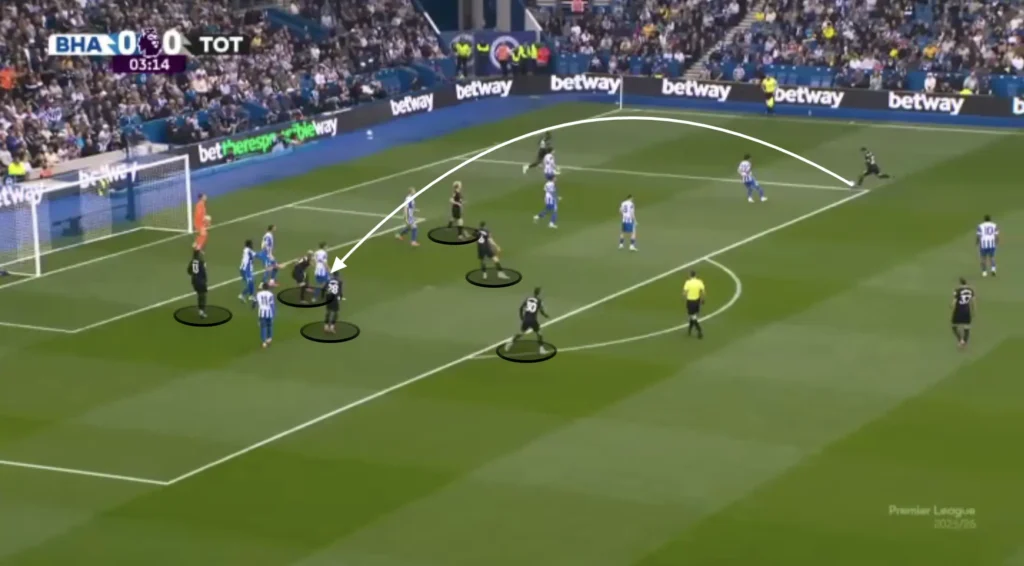
Beyond the initial delivery, having several players in the box allows Tottenham to capitalize on second balls and rebounds more effectively. If the first cross is cleared, the team is well-positioned to immediately recover possession and sustain pressure.
Runs in Behind
Another fundamental component of Tottenham’s attacking approach under Thomas Frank is the constant threat of runs in behind. While the team is generally possession-oriented, they are not rigidly patient. Frank encourages his attackers to make vertical runs whenever space opens up behind the defensive line — even if the pass is not immediately played.
These runs serve multiple purposes. When timed correctly, they can lead directly to through-balls and goal-scoring chances, especially against high defensive lines. Tottenham’s technical midfielders and ball-playing defenders are capable of recognizing and exploiting these moments with accurate long passes or chipped balls over the top. This gives Tottenham a dual threat — they can build patiently through structured combinations or exploit space quickly with direct passes.
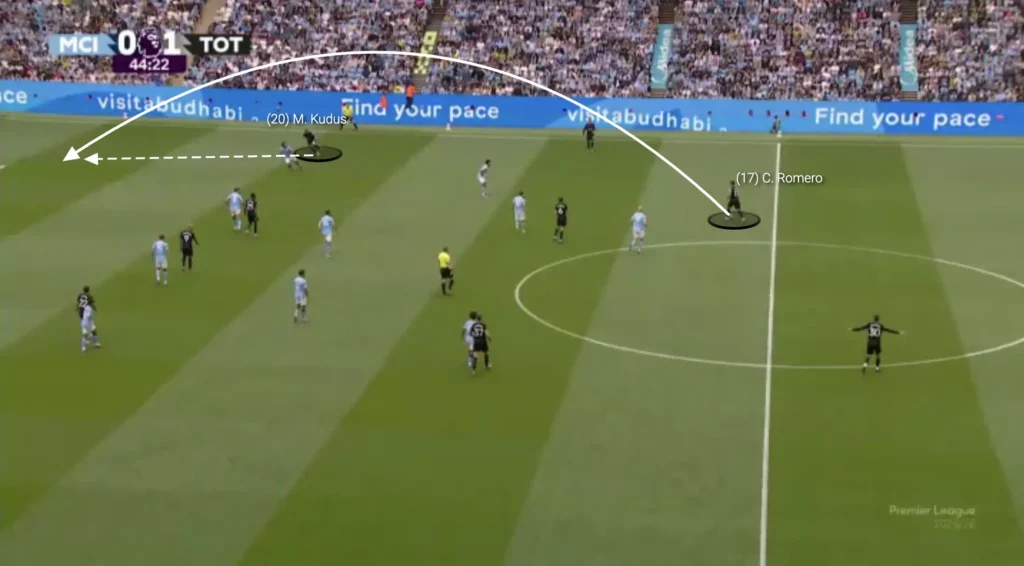
Even when the pass is not played, these runs are still crucial for manipulating defensive shape. The threat of depth forces the opposition backline to retreat a few meters, creating more space between the lines. That space allows Tottenham’s midfielders — especially the number tens or number eights — to receive facing forward, connect play, and progress the attack more easily.
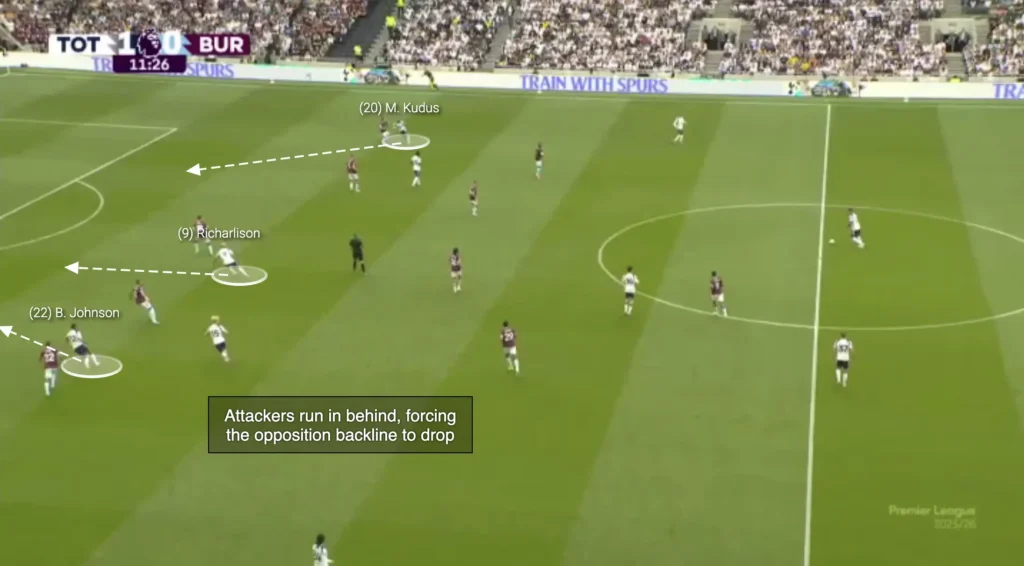
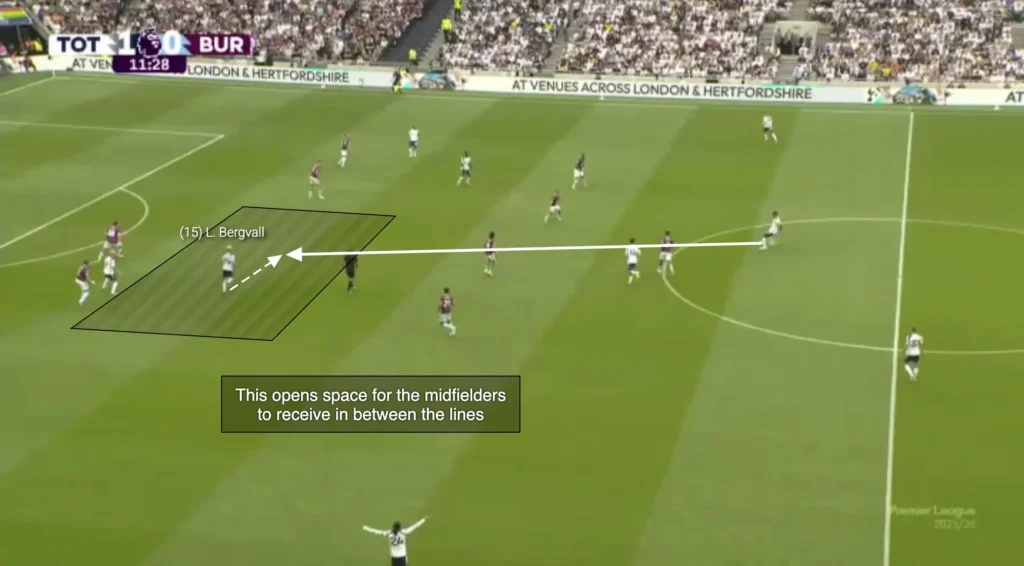
Frank’s system depends on this balance between positional possession and vertical threat. Without runs in behind, opponents could compress the space and suffocate Tottenham’s midfield. With them, the team stretches the field vertically, making their positional play far more effective and unpredictable.
Set-Pieces as an Offensive Weapon
Frank’s long-standing emphasis on set-piece efficiency continues at Tottenham. His side approaches dead-ball situations with the same level of planning as open-play patterns.
Corners: Spurs often use routines starting with most players at the back post, sprinting toward the front zone as the delivery comes in. This movement forces defenders to track runners coming from behind while also monitoring the ball — creating confusion and mismatched timings. The deliveries are typically inswinging, with attackers screening key defenders and the goalkeeper to free aerial targets.
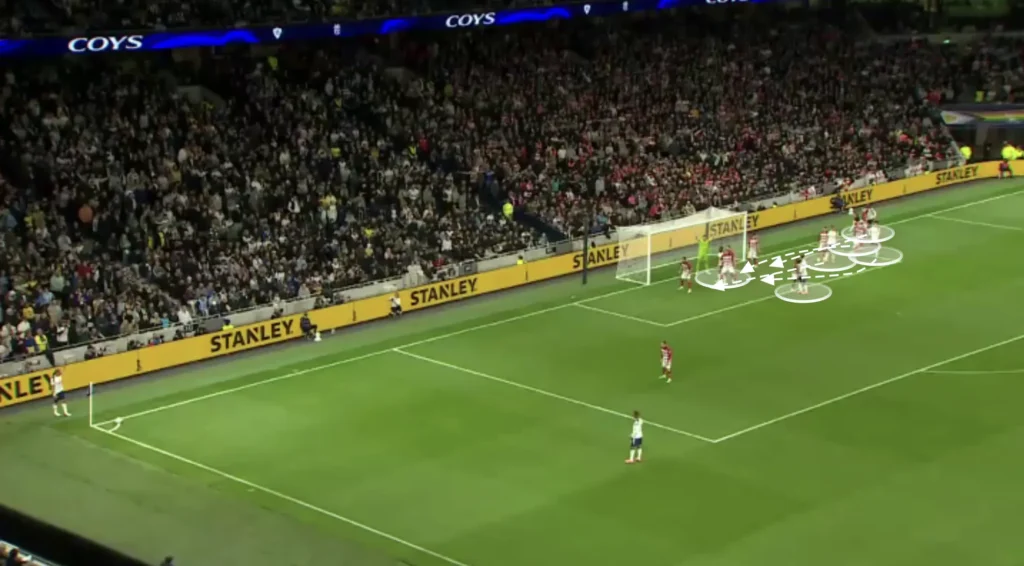
Tottenham also vary routines, for example, occasionally going short to create new crossing angles or find an unmarked player on the edge of the box.
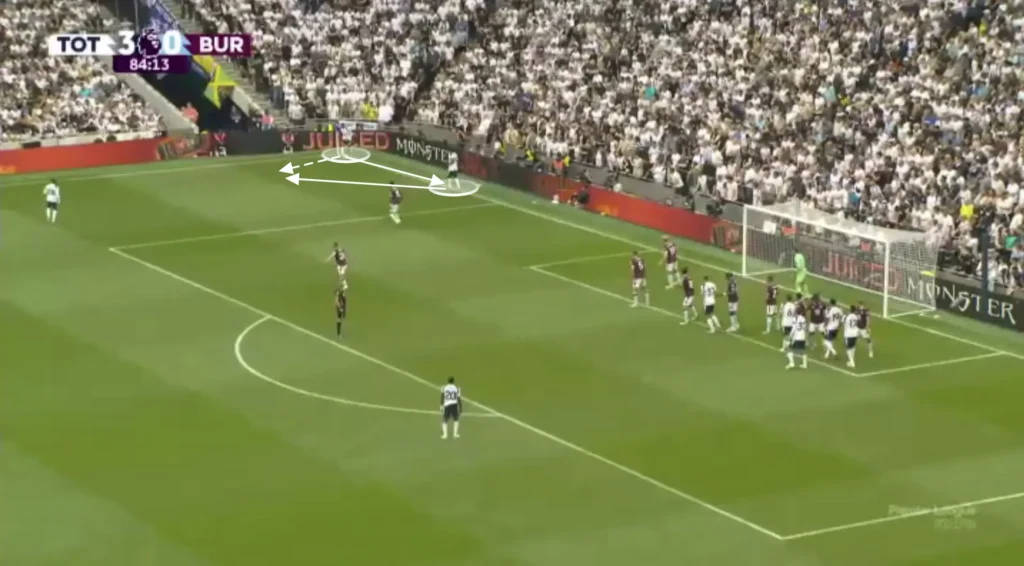
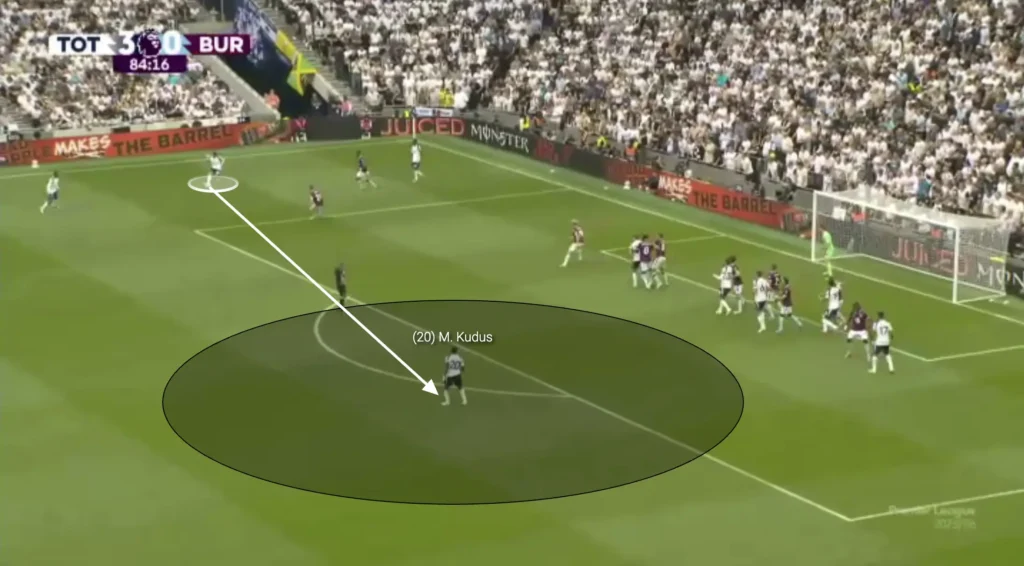
Throw-ins: When Tottenham earns high throw-ins, they use them aggressively, always throwing long into the box. Several players crowd the near post to flick on, while others make delayed runs toward the back post. These rehearsed movements ensure that even partially cleared balls remain threatening.
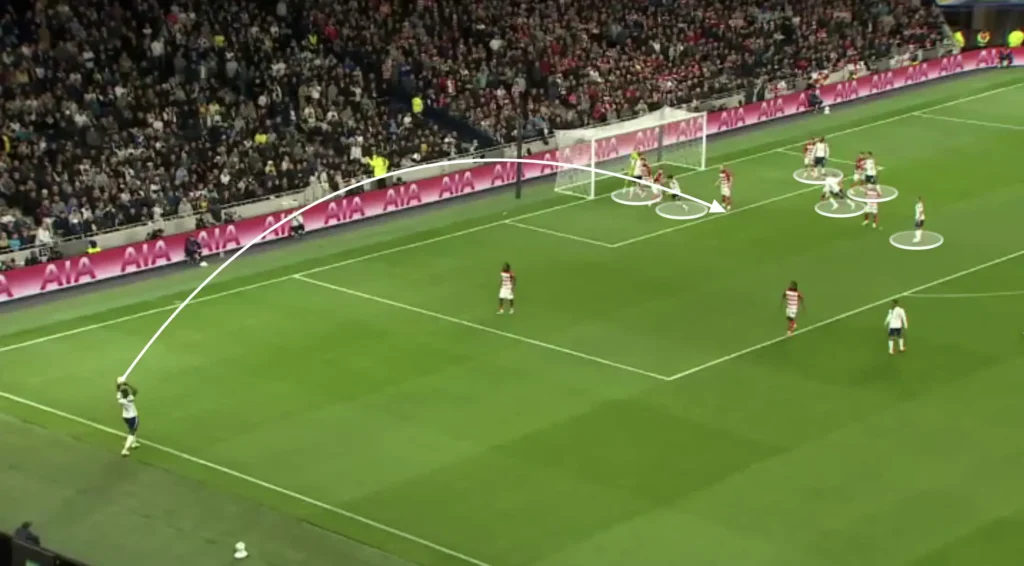
Free-Kicks: Frank’s side also uses long crossing free-kicks from their own half as a territorial tool. The goalkeeper or a defender will play long toward a high line of Tottenham players, allowing them to contest second balls around the penalty area — a way of gaining ground and immediately applying pressure in the attacking third.
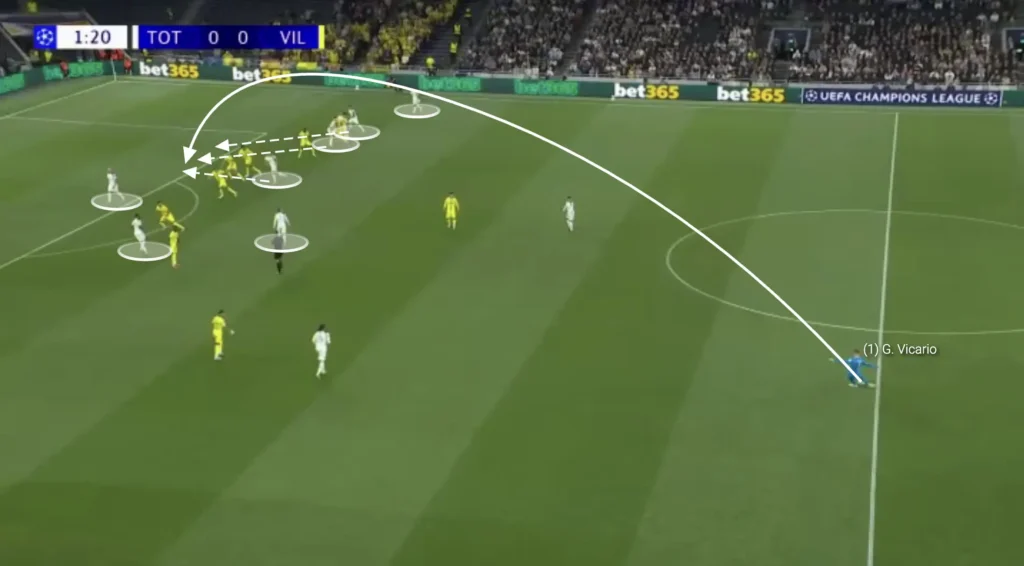
Counterattacking After Winning the Ball
When Tottenham win the ball, they prioritize quick, direct transitions. The first pass is typically played forward immediately, aiming to exploit the opposition before they can organize defensively.
Multiple players join the move rapidly, often including the wingers, the striker, and the central midfielders, creating numerical advantages in the areas they attack. The team’s movement is coordinated, with players occupying key channels to maximize space and passing options.
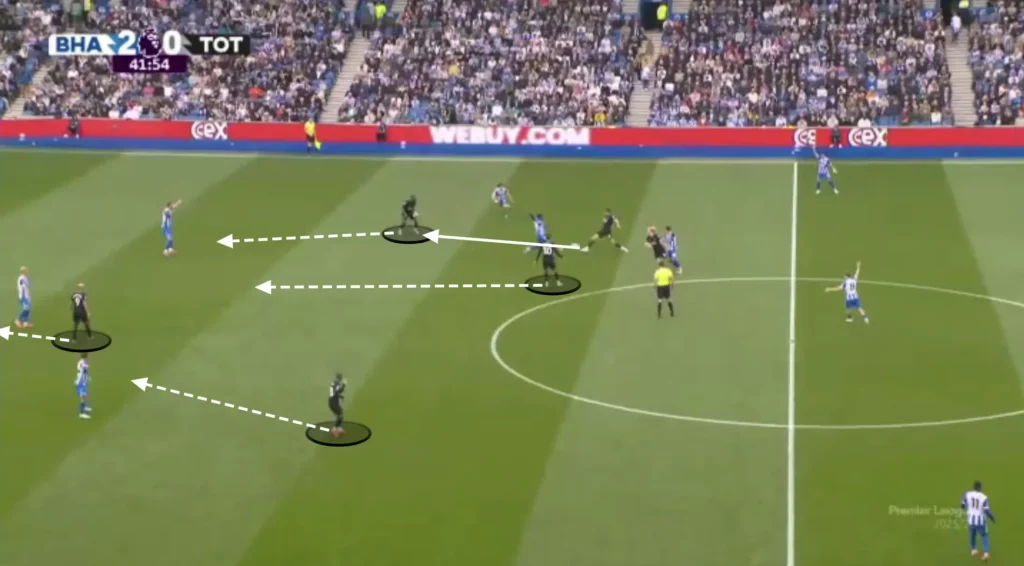
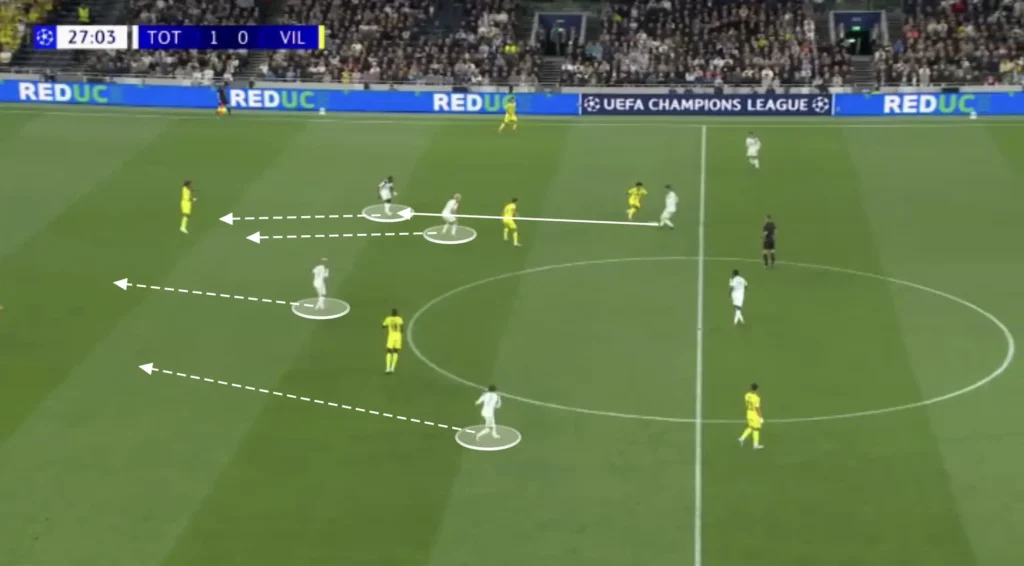
This approach allows Tottenham to generate high-quality chances quickly, turning defensive actions into offensive opportunities while keeping the opponent on the back foot.
Defensive Phase
High Press
Frank’s Tottenham side defends proactively, using an aggressive high-pressing system to disrupt the opposition’s build-up and force mistakes near goal. Their approach is primarily man-to-man, with each player responsible for directly marking an opponent.
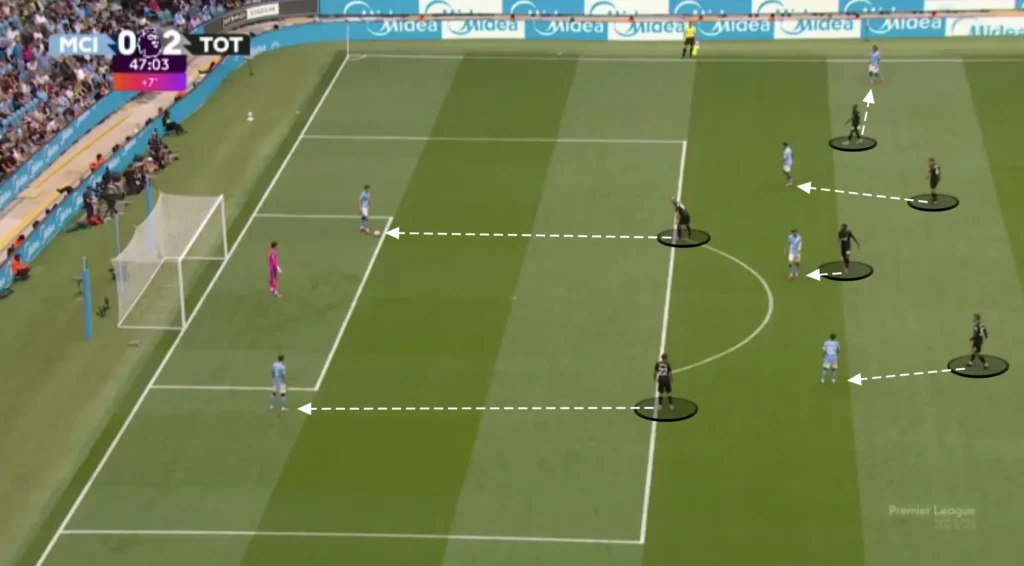
This close marking limits passing options and pressures the opposition into rushed decisions, often leading to turnovers in dangerous areas. Tottenham treat their high press as an attacking weapon, frequently creating goalscoring chances immediately after regaining possession.
The key to their pressing structure lies in understanding distances and priorities. When an opponent is far from the ball, the Tottenham player marking him doesn’t follow tightly but instead moves inward to help close central spaces and prevent 1v1 situations. A general rule is simple: the closer you are to the ball, the closer you should be to your opponent.
However, a man-to-man press comes with several inherent risks. If communication breaks down or even a single player loses his duel, the opposition can bypass the press entirely, progressing through large open spaces and immediately putting Tottenham’s backline under pressure. Since every player is responsible for an individual opponent rather than a zonal area, one mistake can unbalance the entire structure.
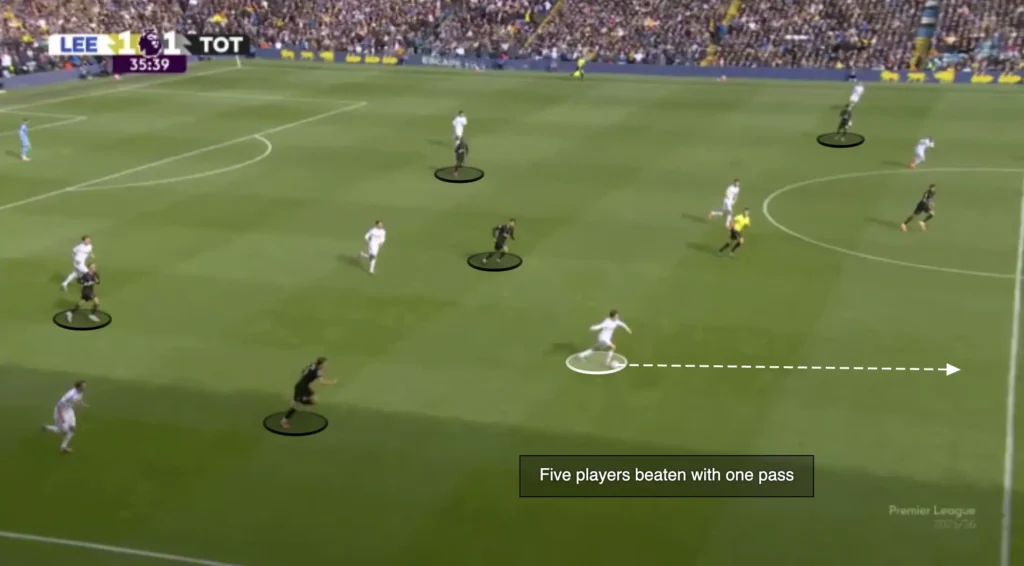
Long balls behind the defense are another frequent challenge. When opponents beat the press with long passes, Tottenham’s defenders often face 3v3 or 4v4 situations in wide-open spaces, demanding precise timing and quick recovery runs.
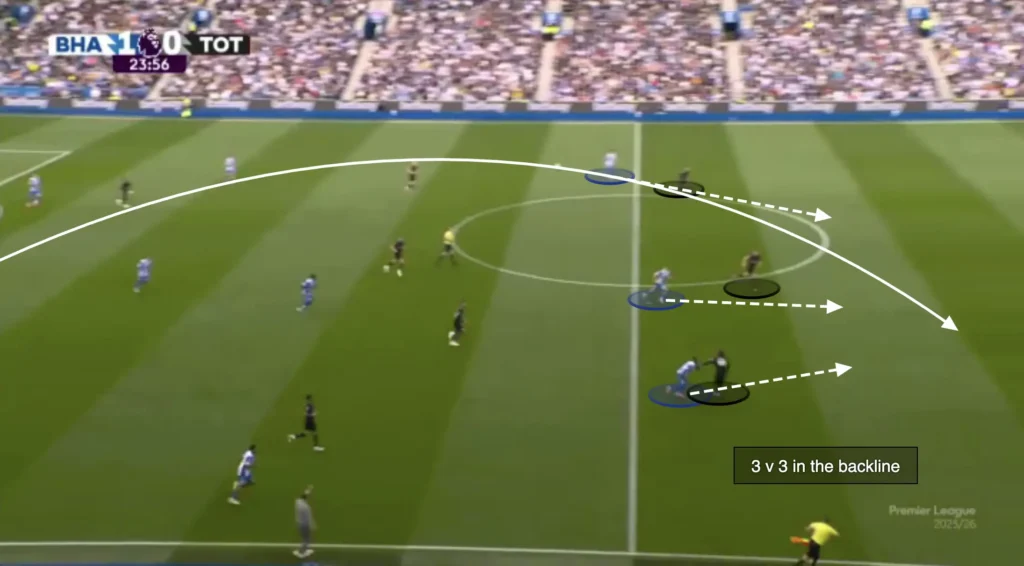
These moments require the defenders to defend large areas and win isolated duels. Against opponents with pace or physical presence up front, these long passes can be difficult to manage and may expose the inherent trade-off of pressing high with a man-oriented approach.
Low Press
When Tottenham is forced deeper, their defensive behavior remains man-oriented, though adapted to a more compact structure. Frank has used various shapes — primarily 4-4-2, 4-2-3-1, and 4-1-4-1 — depending on the opponent’s positioning and attacking patterns.
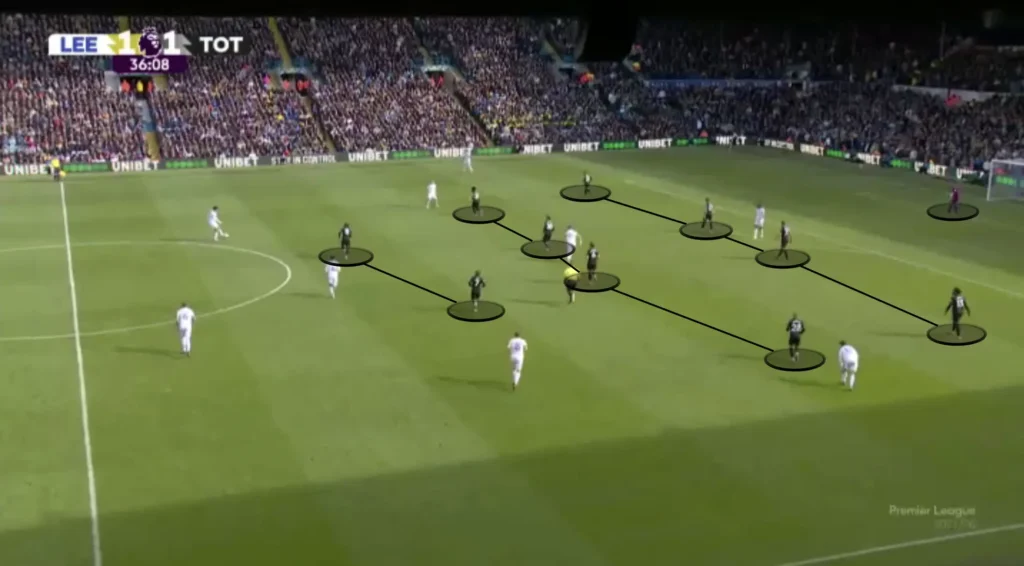
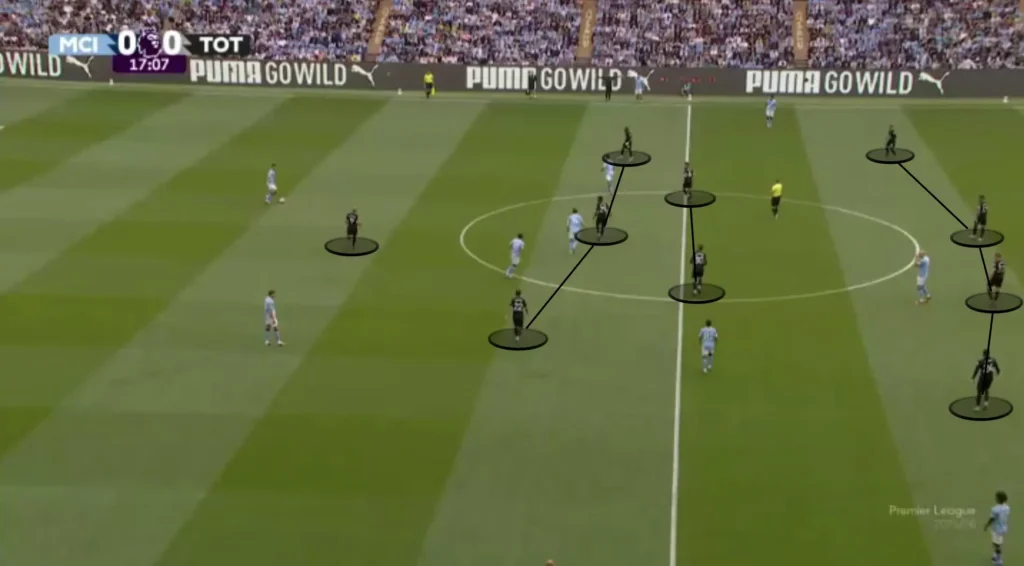
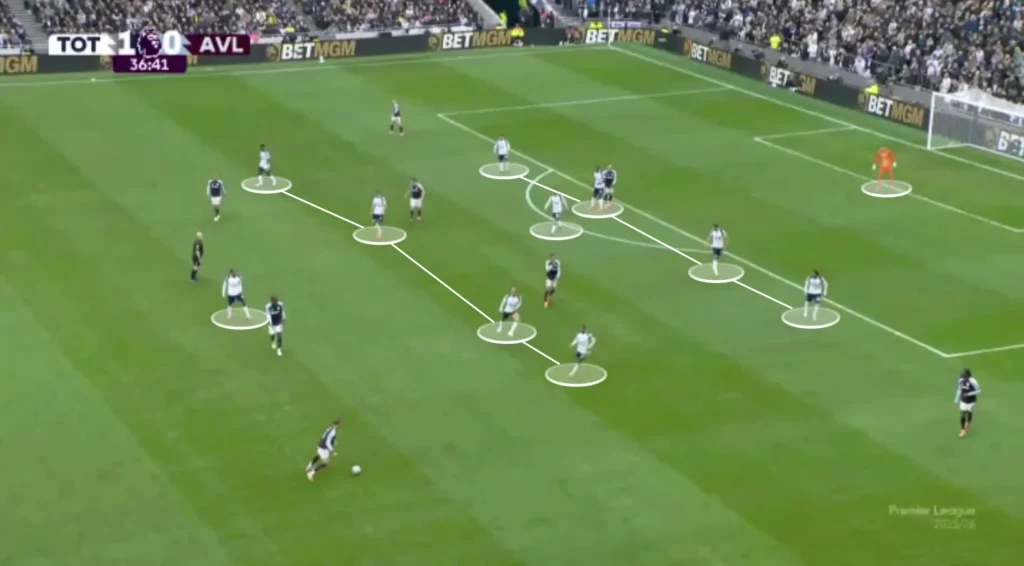
In these setups, Tottenham emphasize close marking, aggressive duels, and collective shifting toward the ball side. Their goal is to reduce central access and force the opponent toward the flanks, where they can press in numbers.
This man-oriented compactness ensures that Tottenham stay active even without the ball, but it also carries risks. If one player leaves his position too early or follows an opponent too far, gaps appear between the lines, which can be exploited by technically sharp teams. Maintaining discipline and communication is therefore key, as Frank’s system depends heavily on every player understanding when to follow, when to hold, and when to pass on a mark.
In this situation, for example, Pedro Porro leaves his right-back position to put pressure on the opposition left-winger receiving the ball in the half-space. This opens up space in behind for the opposition left-back to run into and receive a through ball from midfield, deep into the final third.
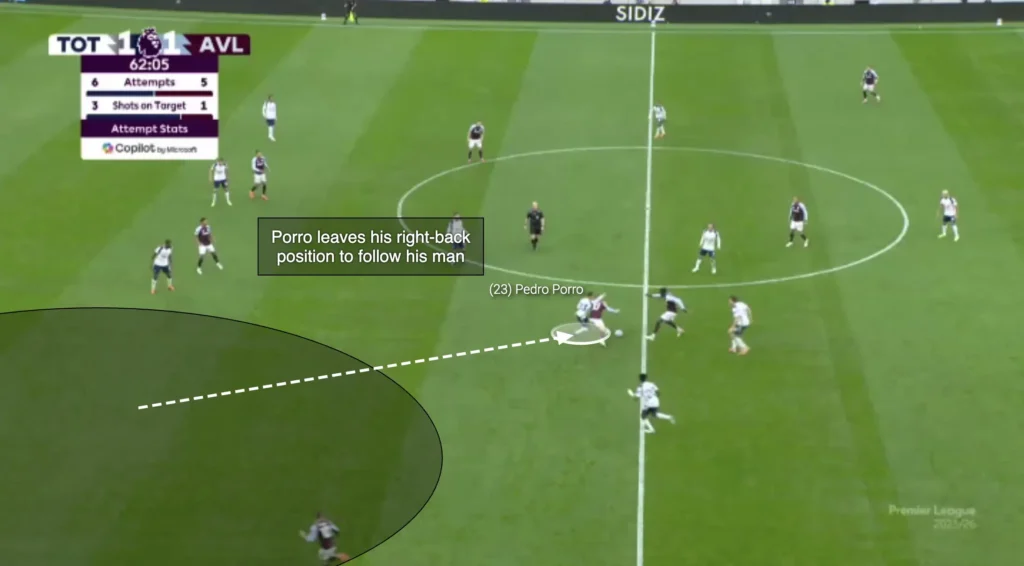
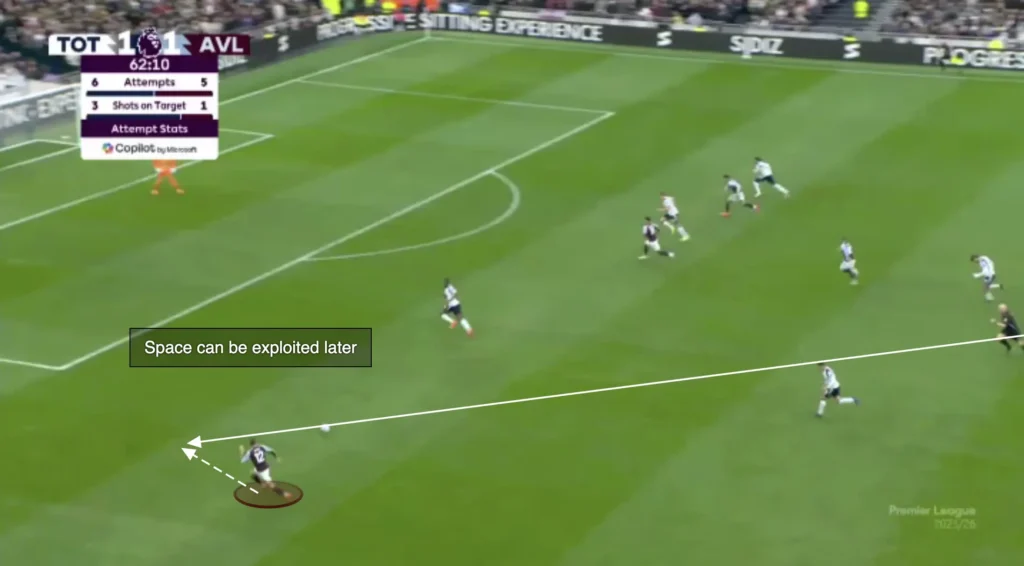
High Defensive Line
A key feature of Tottenham’s defensive setup under Frank is the use of a high backline. This keeps the team compact vertically, reducing the space between defense and midfield and helping them sustain pressure high up the pitch.
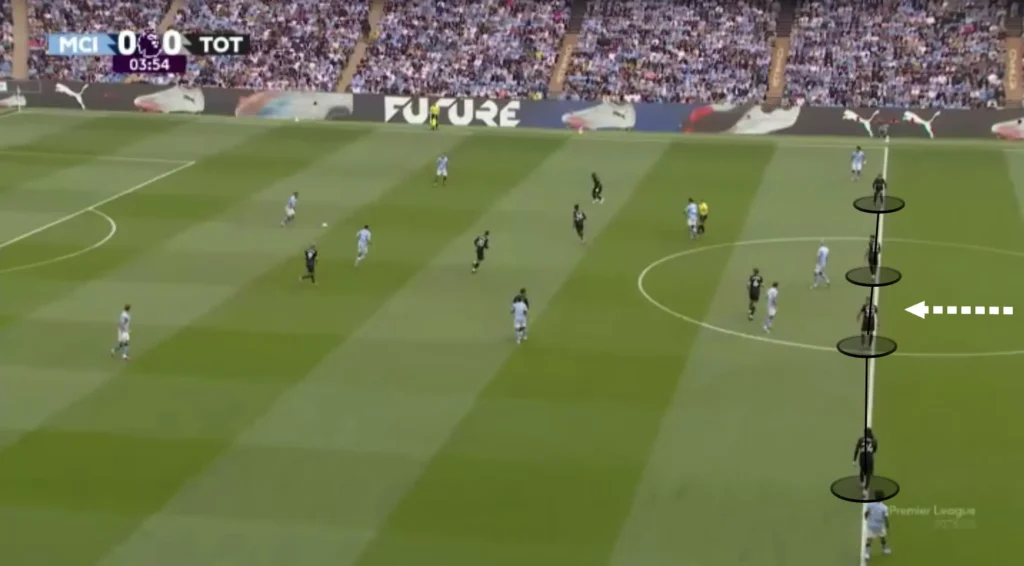
Maintaining this structure requires defenders who are both quick and positionally intelligent to handle balls played in behind. Cohesion is essential — the backline must move as a unit to maintain an effective offside trap and prevent attackers from exploiting gaps between defenders.
Defensive Work Rate and Collective Responsibility
Thomas Frank’s Tottenham defends with remarkable work ethic and collective discipline. The players show a strong understanding of covering for one another — if one steps out of shape to press the ball carrier, a teammate immediately drops back to fill the gap.
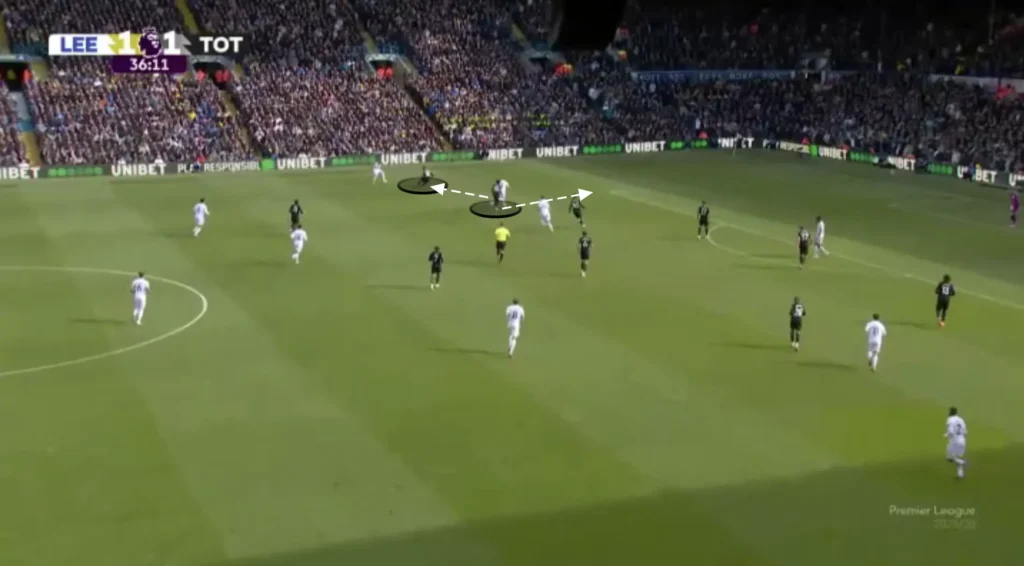
This coordinated effort keeps defensive balance and maintains team compactness even when individual players move out of position. Their collective defensive responsibility reflects Frank’s emphasis on teamwork, intensity, and adaptability — key principles that define Tottenham’s overall identity under his management.
Conclusion
Thomas Frank’s Tottenham reflect a modern, intelligent approach to the game — one built on balance, adaptability, and clarity. His side can dominate with the ball or threaten without it, showing that control in football isn’t only about possession, but about managing moments and spaces.
What stands out most is the team’s cohesion. Every player understands the collective idea, whether in attack, defense, or transition. That shared understanding allows Tottenham to play with intensity and confidence while maintaining a clear identity.
Frank’s Tottenham are a team that doesn’t just react to the game — they shape it. Their tactical discipline, work ethic, and fluidity show what can happen when structure and freedom coexist within the same footballing philosophy.
For more in-depth tactical breakdowns and analysis, explore our other articles on team structures and tactical patterns.
